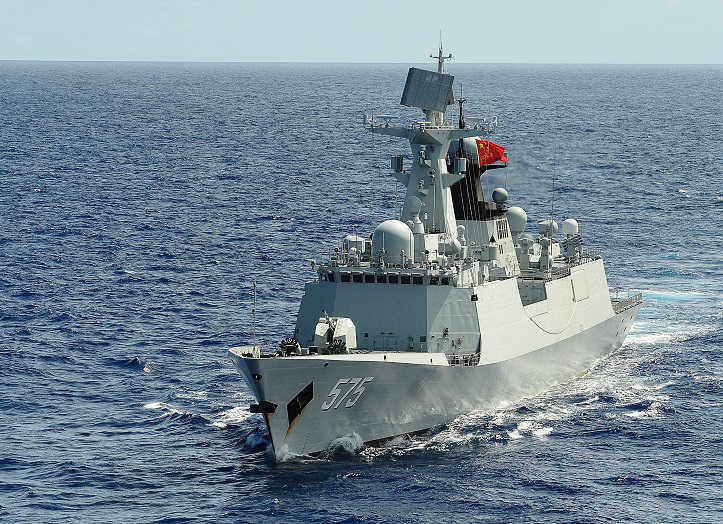Cet article dresse le constat d’une multiplication des différents maritimes en Asie orientale et nous propose son analyse de cette situation complexe. La situation combine en effet des aspects historiques, juridiques et stratégiques. Par ailleurs, la montée en puissance de la Chine et les perceptions qui y sont attachées reformulent la donne. Les auteurs évoquent enfin le rôle que les Etats-Unis pourraient être amenés à jouer.
Les opinions exprimées dans cet article n’engagent pas le CSFRS.
Les références originales de ce texte sont : Barthélémy Courmont, Fédéric Lasserre, Eric Mottet, « Perspectives on maritime disputes in East Asia », Assessing Maritime Disputes in East Asia. Political and Legal Perspectives (London, New York, Routledge, 2017).
Ce texte, ainsi que d’autres publications peuvent être visionnés sur le site de l’IRIS : http://www.iris-france.org/
Perspectives on maritime disputes in East Asia
The maritime disputes in East Asia have multiplied over the past few years, in parallel with the economic growth of the countries in the region, the rise of nationalist movements, fears and sometimes fantasies regarding the emergence of the People’s Republic of China (PRC) as a global power, increasing military expenses, as well as speculations regarding the potential resources in various disputed islands. None of these disputes is new however, as some have been subject to frictions for decades, if not centuries in a few cases. At the same time, none of these disputes has ever been at the origin of a major conflict between Asian countries.
The current situation appears to be, at the practical level, an opposition between lawyers, historians and strategists, each of these categories being represented at various levels within all the countries involved in the disputes. The experts also agree to disagree on what sort of paradigms they mostly rely on, and prove that these disputes are neither exclusively legal, nor historical or based on States strategies. They cannot also be strictly confined to the field, although rather large, of geostrategy. They are instead geopolitical, as they combine all those interpretations and arguments, which has the effect of limiting the possibilities to engage comprehensive dialogues among the parties.
The question whether these disputes can be discussed at the continental level (East Asia) instead of focusing on more regional approaches also has to be raised. A significant number of recent academic works, some of them particularly relevant, have studied the case of South China Sea disputes (Buszynski and Roberts, 2014; Jayakumar and Beckman, 2014; Wu and Nong, 2014). At the same time, some good works have been published on the East China Sea disputes (Samuel, 2013; Manicom, 2014). These publications mostly emphasize on the arguments of different actors involved in the disputes, as well as the historical background. However, the number of works that attempt to expand the analysis at the continental level is rather limited. At the security level, Ralf Emmers’ edited book (2012) is perhaps one of the most comprehensive as it covers the entire zone. At the legal level, Min Gyo Koo’s monograph (2010) provides useful information, although this work has been published prior to the rising tensions that led to the current situation. Assessing Maritime Disputes in East Asia attempts to combine these different elements in order to offer a comprehensive overview of different aspects at stake in the maritime disputes in East Asia. It also aims at understanding whether the resurgence of the maritime disputes in East Asia may be studied on a case by case basis, or should be analyzed as a regional phenomenon with common characteristics.
Historical disputes and legal interpretations: practical and theorical approaches
One may observe at the same time similarities and major differences in the various maritime disputes in East Asia, depending on whether the emphasis has to be put on situations that can be analyzed through a “regional” angle, or must to the contrary be based on case-by-case studies. One may consider the proximity in the history, the rhetoric and of course in the potential consequences in some disputes that are not supposedly having anything in common, that add to the fact that the impact of these disputes can be seen at the regional level, if not international in some cases.
On the other side, the maritime disputes often reflect tensions among the neighboring States in East Asia, and carry their own specificities. Some cases, such as the dispute between Japan and the PRC, oppose what we may consider symmetrical actors, while others such as the disputes in the South China Sea confront asymmetrical actors.
What is the impact of history? How can we explain the fact that most cases have emerged in parallel, and are mostly unresolved cases? Why are maritime disputes in East Asia seemingly more difficult to resolve than in other regions, if it is the case? Shall we interpret these disputes as the demonstration of the existence of an East Asian security knot?
The importance of islands has considerably increased since 1994 and the enactment of the 1982 UN Convention on the Law of the Sea (UNCLOS), that authorizes States to claim a space up to 200 miles around the islands under their sovereignty as part of their Exclusive Economic Zones (EEZ). The UNCLOS defines three distinct areas-territorial waters, exclusive economic zones, and international waters. Territorial waters are those under government sovereign control and legally recognized as twelve nautical miles from the low water mark of a coastal state. This zone is under the exclusive control of the state, but ships of all nations are allowed innocent passage. Beyond twelve nautical miles is the Exclusive Economic Zone (EEZ), which extends seaward to 200 nautical miles. Within an EEZ, the coastal state has sovereign rights to use and exploit marine resources such as oil exploration, seabed mining, and fishing. The international community still enjoys the rights and freedom of navigation and overflight in the EEZ, as well as the ability to lay submarine telecommunications cables and other non-resource related uses of the oceans. Beyond 200 miles is considered international waters (high seas) where all coastal and non-coastal states have equal access and enjoy the freedom of the seas and other activities; coastal States may claim extended continental shelves under article 76, where they enjoy sovereign rights on resources in the seabed and subsoil but must prove there is a physical extension of the continental shelf beyond the 200-mile limit. The UNCLOS has become something of a Constitution for the oceans, and most of its legal authority remains intact (Tuerk, 2012; Tanaka, 2015).
However, although Article 121 of the UNCLOS mentions that rocks that cannot sustain humans and/or economic activities cannot be taken into account, the treaty has had the effect of enhancing maritime disputes sometimes forgotten, as States started to claim territories for which they had not shown much interest in recent history, and sometimes never at all. The absence of clear borders and identifications of EEZ in several cases has increased the tensions, as the States involved have been tempted in giving different interpretations of history. In that sense, the UNCLOS opened a Pandora box in redefining borders, sovereignty and economic zones according to parameters that combined together various aspects and levels of the claims (Pan, 2007; Song and Tønnesson, 2013). Although similar disputes may be observed in several regions on the planet, East Asia concentrates all types of maritime disputes, approaches, and arguments, and considering the growing importance of that region at economic, security, political or diplomatic levels. These disputes, from Dokdo/Takeshima to the Paracels, through Senkaku/Diaoyu and Spratlys, appear critical to the establishment of both bilateral and multilateral dialogues. As a consequence, UNCLOS has “not only provided a legal and normative discourse on Asia’s maritime affairs but also created or magnified maritime disputes in Asia” (Tsai, 2016: 75).
It may be recalled here that all the States involved in the maritime disputes in East Asia are parties to the UNCLOS. In East Asia at large, only the Democratic People’s Republic of Korea (North Korea) and Cambodia are just signatories. By comparison, a significant number of States in Latin America or the Middle East are not even signatories. Does that demonstrate the limits of UNCLOS, since the maritime disputes have not been solved in Asia, more than twenty years after the implementation of the convention?
In parallel with the extension of the territories and potential activities within the EEZ, the UNCLOS has also been taken as an opportunity to secure sea lines, especially for countries such as the PRC or the Republic of Korea, where a “Mahanian” interpretation of the international regulations has been observed considering the dependence on international trade and the importance of access to international waters. Similar observations can be made in the South China Sea, notably the case of the PRC, Vietnam, or Malaysia.
The nationalistic sentiment also undoubtedly plays a significant role in some of the most ferocious maritime disputes in East Asia. It is particularly sensitive in the East China Sea (Manicom, 2010), but also visible in the South China Sea. The rivalry between Japan and the PRC on one side, and Vietnam and the PRC on the other, are just two examples of a paradigm that can be repeated in most situations, with more or less impact on the national postures. However, one cannot consider some sort of determinism in the territorial and maritime disputes in East Asia only based on nationalistic sentiment. Interestingly and in various cases, Asian countries have proven willing to compromise in order to manage and resolve their disputes, and whether through negotiation or the implication and arbitration of a third party, the pace and creativity of such solutions has significantly increased in the past few years. These agreements hold interesting lessons for the current crisis. For instance, the 2000 agreement delimiting the Sino-Vietnamese maritime border in the Gulf of Tonkin created China’s only resolved maritime boundary to these days. The so-called Tonkin Agreements might have enabled future deals, and China made significant compromises in order to reach a deal. At the same time, both Beijing and Hanoi did not use their respective interpretation of the UNCLOS in the negotiation. Rather, international law provided several focal points for the two parties (especially since none had yet ratified the UNCLOS) to cooperate and delimit their respective territorial sees, EEZs and continental shelves. This nuanced approach to legal norms allowed the two countries to reach an agreement. Although covering a small area and not including the disputed islands, these agreements tend to demonstrate to possibility for countries such as China and Vietnam to come to a dialogue in order to solve their maritime border disputes (Colson and Smith, 2005: 3745-3758).
In 2008, the International Court of Justice also resolved a decades-long dispute between Malaysia and Singapore over Pedra Branca, South Ledge and the Middle Rocks (ICJ, 2008). In 2009, Malaysia and Vietnam made a submission to the Commission on the Limits of the Continental Shelf in which they extended claims to the seabed in the South China Sea, and agreed to pursue joint development in the disputed area. The agreement was, however, rejected by the Philippines, also member of the ASEAN, which tends to indicate the limits of such deals at the regional level. The March 2012 decision taken by the International Tribunal for the Law of the Sea (ITLOS) in the Bangladesh/Myanmar maritime border dispute also opened new- possibilities for peaceful resolution of similar cases in the region. It was followed by the civil fishery agreement between Taipei and Tokyo in April 2013 in the particularly disputed Senkaku/Diaoyu islands (see Chapter 7 for further details) and the 2014 agreement between the Philippines and Indonesia on an EEZ boundary in the Celebes Sea that set aside historical claims between the two countries as ancient as the 1898 Treaty of Spain.
Empirically, these recent examples prove at the same time that the maritime disputes in East Asia have several factors in common (historical, political, legal, economic and more), but also that there is no particular determinism in the directions taken to solve them. At the theoretical level, the realist and geopolitical approach that traditionally explores the national interest and the national resources is disputed and well complemented by the liberal approach that advocates the abandon of sovereignty and the respect of international laws, and by the constructivist school, particularly on emphasizing on domestic factors and contributing to the formulation of a nationalistic sentiment. The constructivist approach considers the integration of the various levels of analysis in international relations, which have increasingly come to dominate contemporary theories of diplomacy. One may also take into account the various dimensions of territorial disputes, including material, ideational, structural and legalistic/normative.
The emergence of China as a new paradigm
As China’s economic ascent facilitates growing military capabilities and assertiveness in its regional environment, as a response to what is perceived as a threat or an attempt to compete with an emerging superpower, other players are also experiencing their own rise in nationalism and military capability, and have exhibited greater willingness to stake territorial claims.
More than discussing the reality of the modernization of China’s military capabilities, especially in the navy, one may consider the strong impact on China’s neighbors, especially those engaged in maritime disputes with Beijing. In August 2011, Japan’s Prime Minister Yoshihiko Noda publicly expressed his country’s concerns regarding the rapid development of Chinese capabilities at sea, that summarizes most of China’s neighbors’ current fears:
China’s rapid military build-up and expansion of the range of its military activities, coupled with a lack of transparency of its strategic intentions, are a cause of concern for Japan and the whole region. China’s high-handed attitude toward other countries, when seen against the backdrop of its military capabilities and recent behavior in the South China Sea and elsewhere, may destabilize the international order within the region (quoted in Till, 2012: 22-23).
At the same times, China has been reclaiming more than 2,900 acres of territory in the islands under Beijing’s control since December 2013. It is more than all other claimants combined in the past four decades. Various satellite images have shown unprecedented activity in different islands, including the possible construction of helipads, airstrips, piers and radars. China’s land development has obvious and profound security implications. The potential to deploy China’s military forces to several occupied islands boosts China’s power projection, extending its operational range south and east by as much as 1,000 kilometers. This new- capacity has raised deep concerns among China’s neighbors that led the Filipino expert Richard Javad Heydarian to mention in a recent publication the “tragedy of small-power politics” (Heydarian, 2015: Chapter 4) as a reference to the difficulties for countries such as Vietnam and the Philippines to resist to China’s claims.
For many experts, China’s maritime capabilities remain however still weak in comparison with other major powers, the U.S. in particular, while the continental power is often perceived as Beijing’s key of its emergence as a military superpower (Ye, 2011:259). As Lyle Goldstein also explains, “China remains relatively weak in the crucially important middle domain of maritime power, between commercial prowess and hard military power, which is concerned with maritime governance – enforcing its own laws and assuring ‘good order’ off its own coasts” (Goldstein, 2010: 127). However, China has considerably boosted its navy capabilities in the past decade, to the point that it can be identified as the priority for the development of the People’s Liberation Army (PLA), and a key element of Beijing’s foreign policy (Cabestan, 2010; Cole, 2010). In parallel, the other powers of the region have also enhanced their capabilities, from Japan to India, including the Republic of Korea, Vietnam, the Philippines, Indonesia, Singapore, and since the new arms package announced in Washington, DC, in December 2015, the Republic of China (Taiwan). Most of these postures, developments and acquisitions appear to be linked to China’s emergence as a military superpower in the region, whether these countries perceive it as a potential threat or an opportunity.
China’s new capabilities, along with a new military strategy – although still quite unclear at this stage – have had the effect of changing the balance of maritime powers in the region, with direct implications on the disputed islands and maritime zones. On top of that, China is directly involved in most of the maritime disputes in East Asia – but not all of them, as this volume indicates – and has loudly claimed several islands and maritime zones in parallel with its new maritime capabilities. For these reasons, one may consider China as a key element in East Asia’s current maritime disputes, not only because of Beijing’s intentions, but also considering the other countries’ anticipations and/or reactions to what is sometimes presented as a “power shift” (Hagstrom, 2012).
Beijing also tends to react to the other Asian powers’ postures. For instance, China’s ratification of the UNCLOS has been largely influenced by the posture of its neighbors, more than a comprehensive agreement on the terms of the convention, notably on maritime disputes. Korea and Japan ratified the UNCLOS in 1996.As Xue Guifang points out, “to safeguard its maritime interests, China had to follow suit without delay. Regardless of the concerns for maritime security and disputes with its neighbors, and in spite of dissatisfaction with some of the UNCLOS provisions and innumerable implementation challenges, China ratified the UNCLOS on 15 May 1996 and formally announced the establishment of its EEZ” (Xue, 2010: 179).
Another example of Chinese reaction is of course the Senkaku/Diaoyu dispute in its current phase, since Beijing nationalist posture is the direct result of Japan’s government decision to nationalize the islands in 2010, after purchasing it from private investors (Courmont, 2014). The dispute has a long history, but made a significant turn after this decision, and China’s reaction to it.
Globalization – including extensive free trade pacts between claimants – and more recent developments like the U.S. “pivot” to Asia under the Obama Administration have further connected the two disputes, raising the question of international implications as well as international involvement.
The development of a multilateral, binding code of conduct between China and ASEAN countries is often cited as a way of easing territorial disputes in the South China Sea. The parties have already agreed upon multilateral risk reduction and confidence-building measures in the 2002 Declaration on the Conduct of Parties in the South China Sea, but none have adhered to its provisions or implemented its trust-building proposals. While China has historically preferred to handle all disputes bilaterally, the resumption of negotiations between Beijing and ASEAN still holds promise for reinvigorating a multilateral framework toward greater cooperation and conflict resolution.
If confrontation were to involve Japan in the East China Sea or the Philippines in the South China Sea, the United States would be obligated to consider military action under the defense treaties signed with these countries. However, experts note that Washington’s defense commitments to Tokyo are stronger than those to Manila. Under its treaty obligations, the United States would have to defend Japan in the case of an armed attack; the U.S.-Philippine treaty holds both nations accountable for mutual support in the event of an “armed attack in the Pacific Area on either of the Parties”.
References
Buszynski, Leszek and Christopher B. Roberts (eds.) (2014). The South China Sea Maritime Dispute: Political, Legal and Regional Perspectives (Routledge Security in Asia Pacific Series). New York: Routledge.
Cabestan, Jean-Pierre (2010). La Politique internationale de la Chine. Entre intégration et volonté de puissance. Paris : Presses de Sciences Po.
Cole, Bernard D. (2010). The Great Wall at Sea. China’s Navy in the Twenty-First Century, 2nd edition. Annapolis: Naval Institute Press.
Colson, D. A. and Smith, R. W. (eds.) (2005). International Maritime Boundaries. Vol. V. Leiden: Martinus Nijhoff.
Courmont, Barthélémy (2014). « La relation Chine-Japon : entre rivalité persistante et nécessaire partenariat ». in Mottet, Eric, Frédéric Lasserre and Barthélémy Courmont (dir.), La Chine et le monde. Montréal : PUQ : 149-172.
Emmers, Ralf (2012). Geopolitics and Maritime Territorial Disputes in East Asia (Routledge Security in Asia Pacific). New York: Routledge.
Gill, Bates (2007). Rising Star: China’s New Security Diplomacy. Washington, DC: Brookings Institution Press.
Gorldstein, Lyle J. (2010). “Improving Chinese maritime enforcement capabilities. Challenges and opportunities”. In Erickson, Andrew S., Lyle J. Goldstein and Nan Li (eds.). China, The United States and 21st-Century Sea Power. Defining a Maritime Security Partnership. Annapolis: Naval Institute Press: 126-154.
Hagstrom, Linus (2012). “’Power shift’ in East Asia? A critical reappraisal of narratives on the Diaoyu/SEnkaku islands incident in 2010”. The Chinese Journal of International Relations, 5: 267-297.
Heydarian, Richard Javad (2015). Asia’s New Battlefield. The USA, China and the Struggle for the Western Pacific. London: Zed Books.
International Court of Justice (ICJ) (2008). Sovereignty over Pedra Branca/Pulau Batu Puteh, Middle Rocks and South Ledge (Malaysia/Singapore). 23 May. Retrieved from www.haguejusticeportal.net/index.php?id=9227.
Jayakumar, S., Tommy Koh and Robert Beckman (eds.) (2014). The South China Sea Disputes and Law of the Sea (NUS Centre for International Law series). New York: Edward Elgar Publisher.
Li, Rex (2008). A Rising China and Security in East Asia. Identity Construction and Security Discourse. New York: Routledge.
Manicom, James (2010). “Growing nationalism and maritime jurisdiction in the East China Sea”. China Brief: A Journal of Analysis and Information, 10 (21).
Manicom, James (2014). Bridging Troubled Waters: China, Japan, and Maritime Order in the East China Sea. Washington, DC: Georgetown University Press.
Min, Gyo Koo (2010). Island Disputes and Maritime Regime Building in East Asia: Between a Rock and a Hard Place (The Political Economy of the Asia Pacific). New York: Springer.
Pan, Zhongqi (2007). “Sino-Japanese dispute over the Diaoyu/Senkaku islands: The pending controversy from the Chinese perspective”. Journal of Chinese Political Science, 12 (2).
Rozman, Gilbert (2010). Chinese Strategic Thought Toward Asia. New York: Palgrave McMillan.
Samuel, Daniel B. (ed.) (2013). East Asia’s Maritime Territorial Disputes: Claims and Considerations for the United States (Asian Political, Economic and Security Issues: Global Political Studies). New York: Nova Science Publisher.
Samuels, Richard J. (2007). Securing Japan. Tokyo’s Grand Strategy and the Future of East Asia. Ithaca: Cornel University Press.
Song, Yann-huei & Tønnesson, Stein (2013) “The Impact of the Law of the Sea Convention on Conflict and Conflict Management in the South China Sea”. Ocean Development & International Law, 44 (3): 235-269.
Sutter, Robert G. (2005). China’s Rise in Asia. Lanham: Rowman & Littlefield.
Tanaka, Yoshifumi (2015). The International Law of the Sea. Cambridge: Cambridge University Press.
Till, Geoffrey (2012). Asia’s Naval Expansion. An Arms Race in the Making? London: IISS.
Tsai, Chung-min (2016). “Sino-Japanese relations over the East China Sea: The case of oil and gas fields”. Journal of Territorial and Maritime Studies, 3 (2): 71-87.
Tuerk, Helmut (2012). Reflections on the Contemporary Law of the Sea. Amsterdam: Martinus Nijhoff Publishers.
Wu, Shicun and Nong Hong (eds.) (2014). Recent Developments in the South China Sea Dispute: The Prospect of a Joint Development Regime. New York: Routledge.
Xue, Guifang Julia (2010). “China and the Law of the Sea”. In Erickson, Andrew S., Lyle J. Goldstein and Nan Li (eds.). China, The United States and 21st-Century Sea Power. Defining a Maritime Security Partnership. Annapolis: Naval Institute Press: 175-196.
Ye, Zicheng (2010). Inside China’s Grand Strategy: The Perspective from the People’s Republic. The University Press of Kentucky.
Yoshihara, Toshi and James R. Holmes (2010). Red Star over the Pacific: China’s Rise and the Challenge to U.S. Maritime Strategy. Washington, DC: Naval Institute Press.
Par : Barthélémy COURMONT, Frédéric LASSERRE, Eric MOTTET
Source : Institut de Relations Internationales et Stratégiques
Mots-clefs : Asia, China, conflict, EEZ, EU, maritime disputes, military, sea

































